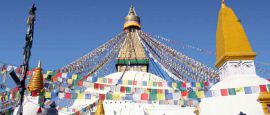Nepal Weather, climate and geography
Weather & climate
Nepal's climate varies greatly with altitude, but the country generally has four distinct seasons. Spring (March to May) is warm and pleasant, with temperatures ranging from 16–28°C (61–82°F) in Kathmandu, and is known for clear skies and blooming rhododendrons. Summer and the monsoon season (June to August) bring heavy rainfall and higher humidity, with temperatures of 20–30°C (68–86°F) in the lowlands; trekking conditions can be challenging due to landslides and cloud cover. Autumn (September to November) offers the best weather for travel, with stable conditions, clear mountain views and temperatures between 15–27°C (59–81°F). Winter (December to February) is cool in the Kathmandu Valley, ranging from 2–18°C (36–64°F), while mountain regions become very cold and may see snowfall.
For trekkers, autumn (September to November) is the most popular trekking season. Expect clear skies, stable weather and excellent visibility of the Himalayan peaks. Spring (March to May) is also ideal, with mild temperatures, longer daylight hours and hillsides brightened by blooming rhododendrons. Winter treks are possible at lower elevations but can be very cold.
Light to medium-weight clothing is suitable for spring and autumn, while summer requires breathable, quick-drying layers due to heat and humidity. A waterproof jacket, rain cover for bags and sturdy footwear are essential during the monsoon season. Winter visitors to Kathmandu will need warm layers, and anyone travelling to higher elevations should be prepared for cold temperatures year-round, with insulated jackets, thermal layers, gloves and hats. For trekking, proper hiking boots, moisture-wicking clothing and a warm fleece are recommended. Modest dress is appreciated in religious and rural areas.
Geography
Nepal is a landlocked country nestled between India and China, celebrated for its dramatic landscapes and remarkable altitude range. The country rises from the low-lying Terai plains in the south — warm, fertile and close to sea level — to the towering Himalayas in the north, home to eight of the world's fourteen highest peaks, including Mount Everest. Between these extremes lie the Middle Hills, a region of terraced fields, river valleys and traditional villages where much of daily life unfolds.
This steep geographic gradient creates distinct climates and ecosystems: subtropical forests in the Terai, temperate hills around Kathmandu and Pokhara, and alpine environments in the high mountains. Nepal is also shaped by major rivers like the Gandaki, Koshi and Karnali, which carve deep gorges as they flow south toward the Ganges. For visitors, this varied terrain means you can experience jungle safaris, tranquil lakes, and world-famous trekking routes all within one small but extraordinarily diverse country.
Do you have any Feedback about this page?
© 2025 Columbus Travel Media Ltd. All rights reserved. No part of this site may be reproduced without our written permission, click here for information on Columbus Content Solutions.




 You know where
You know where